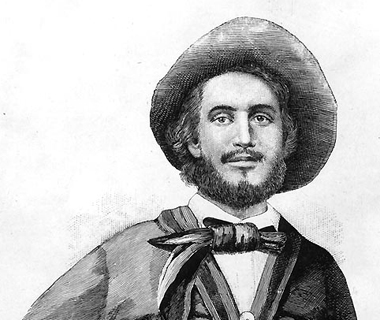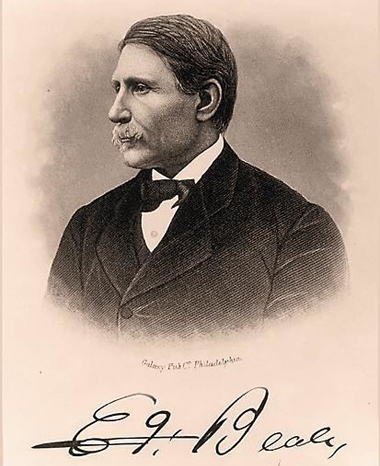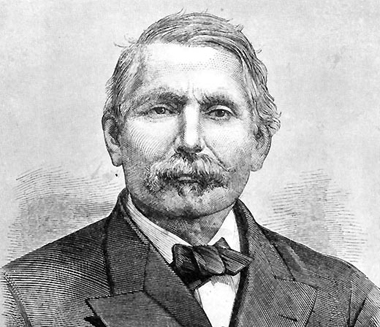Brigadier General Edward Fitzgerald Beale
(February 4, 1822 - April 22, 1893)
Edward Fitzgerald Beale was born Feb. 4, 1822 in the District of Columbia. His father George, a paymaster in
the Navy, had earned a Congressional Medal for Valor in the War of 1812. His mother, Emily, was the daughter
of Commodore Thomas Truxtun. Ned was a student at Georgetown College when, at the solicitation of his widowed
mother, President Andrew Jackson appointed him to the Naval School. Beale graduated in 1842.
After a promotion to acting sailing master, he sailed for California in October 1845 on the frigate "Congress"
under Commodore Robert Stockton. But 20 days later Stockton sent Beale back to Washington with important dispatches.
After a long and roundabout voyage, he reached Washington in March 1846. Promoted to the grade of master, he
sailed for Panama and then overtook the "Congress" at Callo, Peru, in May 1846.
Hostilities with Mexico had already begun when the vessel reached Monterrey on July 20. After reaching San Diego,
Stockton dispatched Beale to serve with the land forces. He and a small body of men under Lt. Archibald Gillespie
joined Gen. Stephen Kearney's column just before the disastrous battle of San Pasqual (Dec. 6, 1846). After the
Mexican Army surrounded the small American force and threatened to destroy it, Beale and two other men (his
Delaware Indian servant and
Kit Carson) crept through the Mexican lines and made their way to San Diego for
reinforcements. Their actions saved Kearney's soldiers. Two months later (Feb. 9, 1847), although Beale still
suffered from the effects his adventure, Stockton again sent him east with dispatches. Beale reached Washington
about June 1. In October he appeared as a defense witness for
John Fremont
at the "Pathfinder's" court martial.
Within the next two years, Beale made six more journeys across the country. On the second of these
(July-September 1848), he crossed Mexico in disguise to bring the federal government proof of California's
gold. After the fourth journey he married Pennsylvania Representative Samuel Edwards' daughter, Mary,
on June 27, 1849. After making lieutenant on Aug. 3, 1850, Beale resigned from the Navy in May 1851.
He returned to California as a manager for W.H. Aspinwall and Commodore Stockton, who had acquired large
properties in America's newest territory. On March 3, 1853, President Millard Fillmore appointed Beale
Superintendent of Indian Affairs for California and Nevada. Congress appropriated $250,000 to improve
native conditions in Beale's district. With a party of 13 others he left Washington for California
on May 6, 1853. Beale's party crossed southern Colorado and southern Utah assessing the feasibility of the
route for a transcontinental railroad. He reached Los Angeles on Aug. 22. Beale retained his position as
superintendent until 1856. California Governor John Bigler also appointed him brigadier general in the
California Militia to give him additional authority to negotiate peace treaties between the
Native Americans
and the U.S. Army.
In 1857, President James Buchanan appointed Beale to survey a wagon road from Fort Defiance, New Mexico to the
Colorado River,
on the border between Arizona and California. The survey also incorporated an experiment first proposed
by Secretary of War Jefferson Davis four years earlier. To satisfy part of his transportation needs, Beale
took 25 camels, imported from Tunis, as pack animals during this expedition and on another in 1858
through 1859. Beale felt the camels performed well. But they scared horses and mules, so the Army declined
to continue the experiment. After Abraham Lincoln's inauguration in 1861, the president appointed Beale Surveyor
General of California and Nevada. Beale asked Lincoln for a Union Army command, but the president convinced
him he could better serve the country by remaining as surveyor general and helping keep California in the Union.
After the Civil War, Beale retired to Rancho Tejon, part of 270,000 acres he had acquired near present-day
Bakersfield, California. In 1870 he bought the Decatur House in Washington, D.C. After that he divided his
time between his two homes. In 1876 President Ulysses Grant appointed Beale as Minister to Austria-Hungary, a
post he held for a year. Grant also suggested Beale as Navy Secretary during President Chester Arthur's
administration, but Arthur preferred someone else. Beale died at Decatur House on April 22, 1893.
During World War II, Camp Beale (now Beale Air Force Base) was named in his honor
Associated photo tours
Route 66 - Fort Tejon
Also see - John Charles Fremont
Old Spanish Trail
Lieutenant Edward Fitzgerald Beale led a group along the North Branch and then down the ... Beale had been appointed as Indian Commissioner to California. ...
Human Impacts on the Mojave National Preserve Area
...Beale directed a government land survey in 1853. One historic inscription reads "Stuart, 4th Inft. May 16, 1851" [though the last digit may be another ...
Chronology of expeditions between New Mexico and California
...The E. F. Beale party follows the Santa Fe Trail and Old Spanish Trail from Missouri to California and go back on the same route. Also see: ...
Fort Tejon
Fort Tejon, Tejon Pass, CA, Beale. ... Edward F. Beale · Henry J. Carleton · Mojave Desert Military History · History of Fort Tejon ...
Fort Piute (Fort Beale)
When the then Major Carleton established his chain of desert redoubts in 1859 and 1860, the first one west of Fort Mojave was what Carleton named Fort Beale ...
Fort Tejon
Lieutenant Beale, associated with all facets of Fort Tejon's history, made the post ... The experimental use of camels was so successful that Beale strongly ...
Mojave History - The Military & Pioneer period
An expedition under the leadership of Edward Fitzgerald Beale, Superintendent of Indian Affairs in California, a man who had a long acquaintance with ...
Military in the Mojave Desert
Within the next two years, Beale made six more journeys across the country. On the second of these (July-September 1848), he crossed Mexico in disguise to . ...
Camp Cady
It is reported that there is a large body of men east of Beale's Crossing on the Colorado River, and it is possible, though not probable, that they will ...
Fort Soda, Hancock's Redoubt
It was 35 miles from Camp Cady, the nearest post to the west, and 75 to Fort Beale in the Piute Mountains to the east. After 1860 most of the posts were not ...

Beale's Wagon Road
Mojave Road
Camel Corps
Rancho La Liebre
Fort Tejon

